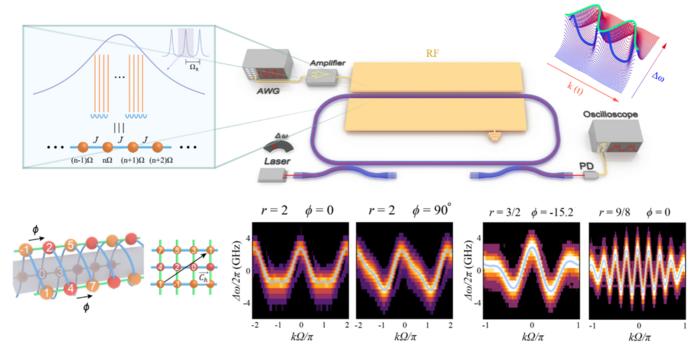Recently, a prominent research team from the University of Science and Technology of China, led by the esteemed Prof. Li Chuanfeng, has made significant strides in the realm of quantum photonics. The team’s innovative research culminated in the development of an advanced on-chip photonic simulator capable of emulating arbitrary-range coupled frequency lattices integrated with gauge potential. This noteworthy study was published in the highly regarded journal, Physical Review Letters. The advancements presented in their research reflect a critical evolution in the field of quantum simulation, one that could have profound implications for the understanding of quantum systems.
Quantum simulators have been a focal point in the study of quantum physics, facilitating the exploration of complex quantum phenomena. The ability to replicate the intricate dynamics of real-world systems has driven researchers to seek effective methods of simulation. Photonic systems have emerged as frontrunners in this pursuit, owing to their inherent versatility and the capacity to manipulate various properties, such as polarization and frequency. However, the journey to create efficient frequency lattices that can accurately simulate complex structures, such as chains of atoms or nanotubes, has remained a formidable challenge within the domain of quantum physics.
The research team employed thin-film lithium niobate chips in their novel approach to address this challenge. These particular chips are known for their high electro-optic coefficient, which is crucial for designing effective frequency lattices. By harnessing the unique properties of these materials, the researchers skillfully modulated an on-chip resonator to observe band structures—an important development in the quest to synthesize complex frequency lattices with arbitrary-range coupling. This achievement is significant as it unlocks new potential for simulating intricate quantum systems that were previously challenging to replicate.
One of the groundbreaking aspects of this study is the team’s ability to achieve coupling that extends to 8 and 9 times the lattice constant. This remarkable feat was accomplished while simultaneously reducing the modulation frequency requirement by over five orders of magnitude, a drastic improvement that opens new pathways for quantum simulation. By integrating multiple lattice points within a single resonant peak, the researchers effectively navigate the complexities of applying and detecting multiharmonic signals, which are conventionally associated with ultra-high-frequency operations in on-chip technologies.
The implications of this groundbreaking work extend far beyond merely simplifying frequency modulation. It offers substantial advancements toward overcoming the intrinsic challenges posed by high-frequency operations in on-chip synthetic dimensions. The researchers successfully maintained the scalability of traditional implementation methods, paving the way for future explorations into higher-dimensional quantum systems. The realization of high-dimensional and complex frequency synthetic dimensions on thin-film lithium niobate optical chips marks a pivotal moment in the field and exemplifies the potential of photonic technologies in quantum research.
Reviews from experts in the field have been overwhelmingly positive, highlighting that this work not only addresses ongoing challenges in quantum simulation but also opens a new avenue for research in synthetic dimensions on photonic chips. By providing a platform that enables the exploration of previously inaccessible quantum phenomena, this research could lead to groundbreaking discoveries and innovations in various applications. The synthesis of on-chip photonic systems may encourage further advancements in quantum computing, materials science, and fundamental physics.
As the landscape of quantum technology continues to evolve, this research represents a critical step forward. The innovative methodology established by the team at USTC holds promise for a new era of quantum experimentation, allowing for the observation and manipulation of systems that were once thought to be too complex to analyze. By leveraging the capabilities of on-chip photonic simulators, researchers can now embark on a journey to probe the intricacies of quantum behavior with unprecedented precision.
In conclusion, the achievements of Prof. Li Chuanfeng and his team stand as a testament to the potential of photonic technologies in the exploration of quantum systems. Their pioneering work not only enhances our understanding of complicated quantum phenomena but also sets the stage for future discoveries in the realms of quantum computing and material sciences. As we look forward to ongoing advancements in this exciting field, the implications of this research promise to reshape our comprehension of the quantum world and drive innovation in numerous scientific domains.
Subject of Research: On-Chip Photonic Simulation of Arbitrary-Range Coupled Frequency Lattices
Article Title: On-Chip Photonic Simulating Band Structures toward Arbitrary-Range Coupled Frequency Lattices
News Publication Date: 5-Dec-2024
Web References: https://journals.aps.org/prl/
References: http://dx.doi.org/10.1103/PhysRevLett.133.233805
Image Credits: Zhao-An Wang et al.
Keywords
Lattice models, Quantum photonics, Frequency lattices, On-chip simulation, Synthetic dimensions





